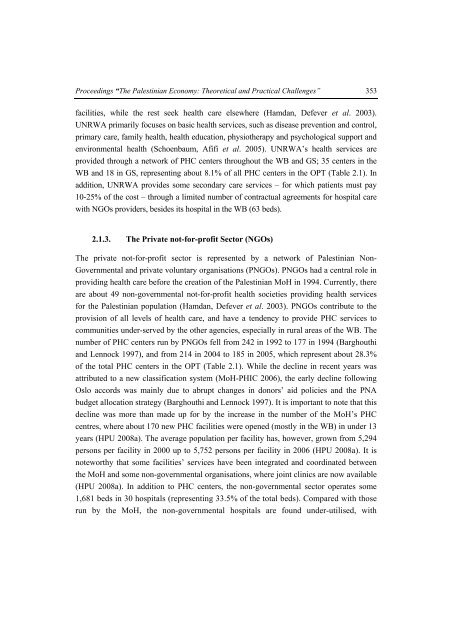The Palestinian Economy. Theoretical and Practical Challenges
The Palestinian Economy. Theoretical and Practical Challenges
The Palestinian Economy. Theoretical and Practical Challenges
You also want an ePaper? Increase the reach of your titles
YUMPU automatically turns print PDFs into web optimized ePapers that Google loves.
Proceedings “<strong>The</strong> <strong>Palestinian</strong> <strong>Economy</strong>: <strong>The</strong>oretical <strong>and</strong> <strong>Practical</strong> <strong>Challenges</strong>” 353<br />
facilities, while the rest seek health care elsewhere (Hamdan, Defever et al. 2003).<br />
UNRWA primarily focuses on basic health services, such as disease prevention <strong>and</strong> control,<br />
primary care, family health, health education, physiotherapy <strong>and</strong> psychological support <strong>and</strong><br />
environmental health (Schoenbaum, Afifi et al. 2005). UNRWA’s health services are<br />
provided through a network of PHC centers throughout the WB <strong>and</strong> GS; 35 centers in the<br />
WB <strong>and</strong> 18 in GS, representing about 8.1% of all PHC centers in the OPT (Table 2.1). In<br />
addition, UNRWA provides some secondary care services – for which patients must pay<br />
10-25% of the cost – through a limited number of contractual agreements for hospital care<br />
with NGOs providers, besides its hospital in the WB (63 beds).<br />
2.1.3. <strong>The</strong> Private not-for-profit Sector (NGOs)<br />
<strong>The</strong> private not-for-profit sector is represented by a network of <strong>Palestinian</strong> Non-<br />
Governmental <strong>and</strong> private voluntary organisations (PNGOs). PNGOs had a central role in<br />
providing health care before the creation of the <strong>Palestinian</strong> MoH in 1994. Currently, there<br />
are about 49 non-governmental not-for-profit health societies providing health services<br />
for the <strong>Palestinian</strong> population (Hamdan, Defever et al. 2003). PNGOs contribute to the<br />
provision of all levels of health care, <strong>and</strong> have a tendency to provide PHC services to<br />
communities under-served by the other agencies, especially in rural areas of the WB. <strong>The</strong><br />
number of PHC centers run by PNGOs fell from 242 in 1992 to 177 in 1994 (Barghouthi<br />
<strong>and</strong> Lennock 1997), <strong>and</strong> from 214 in 2004 to 185 in 2005, which represent about 28.3%<br />
of the total PHC centers in the OPT (Table 2.1). While the decline in recent years was<br />
attributed to a new classification system (MoH-PHIC 2006), the early decline following<br />
Oslo accords was mainly due to abrupt changes in donors’ aid policies <strong>and</strong> the PNA<br />
budget allocation strategy (Barghouthi <strong>and</strong> Lennock 1997). It is important to note that this<br />
decline was more than made up for by the increase in the number of the MoH’s PHC<br />
centres, where about 170 new PHC facilities were opened (mostly in the WB) in under 13<br />
years (HPU 2008a). <strong>The</strong> average population per facility has, however, grown from 5,294<br />
persons per facility in 2000 up to 5,752 persons per facility in 2006 (HPU 2008a). It is<br />
noteworthy that some facilities’ services have been integrated <strong>and</strong> coordinated between<br />
the MoH <strong>and</strong> some non-governmental organisations, where joint clinics are now available<br />
(HPU 2008a). In addition to PHC centers, the non-governmental sector operates some<br />
1,681 beds in 30 hospitals (representing 33.5% of the total beds). Compared with those<br />
run by the MoH, the non-governmental hospitals are found under-utilised, with
















